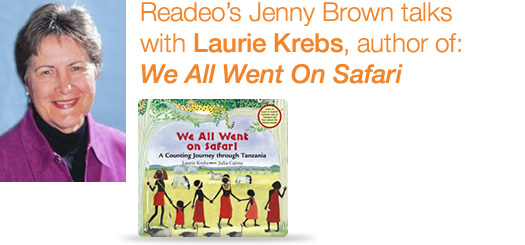


Laurie Krebs, the author of We All Went on Safari, traveled to Tanzania (pronounced tan-za-NEE-uh) with her husband. She saw all of the places and all of the animals that she mentions in her book (and gives more details and a map at the back of the book). She even learned how to count to 10 in Swahili! Here she tells us what it was like to travel through East Africa, and across the Serengeti where the Maasai people live among these stunning animals.
Is the “ancient crater floor” that you talk about (on the page with the four “lordly lions”) the same as the Ngorongoro Crater that you show on the map at the back of the book?
Yes. The Ngorongoro Crater is an upside-down volcano. We stayed at the top of the crater, and then we’d travel by vehicle down into the crater. The topography changes as you go toward the bottom into this amazing place. These particular animals do not have to travel like they do over the Serengeti. They’re protected geographically because it is a crater. The water supply is more stable there. It’s a beautiful place where both the creatures and the Maasai live.
Tell us about the Serengeti.
The Serengeti goes on and on and on. The entire horizon is just grasslands. You could see the wildebeests parading from the Serengeti of Tanzania and on up North to Kenya to follow the water supply. Different animals eat grass at different levels. The zebras eat the lowest grass. For the wildebeest, the grass was a little higher. The antelope would eat the highest grass. The mouths on the different kinds of animals were created to take care of the different levels of grass. That’s why the animals seem to go in tandem with one another.
Is there really a Serengeti gate (on the page with the 8 “wiry warthogs”)?
Yes there is. It’s an entrance into the park. I sent a photograph of that to Julie Cairns, the illustrator.
Did you give the artist any other tips–about the animals or the clothes the Maasai would wear?
For eight years, Julie Cairns had lived in Botswana [which is just north of South Africa; Tanzania is in the Northeast of Africa]. She had drawn the Maasai people in many of her art creations and also in a number of her titles for Barefoot Books. The Maasai people are very tall and handsome, with very erect posture. There’s a certain way they hold their chins, and I think she captured that beautifully. I didn’t have to educate her at all on the Maasai people.
Do the Maasai only dress in red? We liked their beaded necklaces and headbands.
They dress mostly all in red, and in various plaids and stripes. In some cases they do go off a little into the purple or orange side of the red. This is a cultural thing that they hold very dear.
How did you choose the 10 animals you would focus on?
The animals were in different settings throughout Tanzania—in the crater, on the water, in the jungle—so I chose animals that actually lived in the areas I wrote about. I also chose the animals I thought children would most enjoy.
Did you learn Swahili while you were there?
I did learn a little Swahili! “Hello,” “thank you,” “you’re welcome.” And I learned how to count. We kept looking for leopards, and our guide asked, “Wapi chui?” (Wapi is pronounced “WHOP-pee”; the pronunciation for “chui” is at the back of the book!)
Have you also traveled to the Amazon, where your book We’re Roaming in the Rainforest takes place?
Yes, we went to the Peruvian Amazon. We stayed at the confluence of the Amazon and the Tahuayo Rivers, and then we’d travel in dugout canoes to different areas. The creatures were fascinating. The jungle was every bit as dense and flowery and leafy as I had envisioned it.


Dear Jenny,
Thank you so much for doing such a nice job with our interview. Again, I really enjoyed talking with you.
Gratefully, Laurie
Dear Laurie,
I want to travel with you on all of your fabulous trips! You make such interesting observations about the places you go and the animals and people you meet. It was fascinating talking with you, and I can’t wait to see what (or should I say “where”) you write about next.
Your fan, Jenny